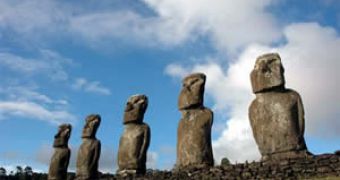Frankly, I'm a little surprised by this story. The standard account of the Easter Island ecosystem destruction seemed quite solid. But the new evidences leave little doubt: the conventional story was wrong - the destruction of the Easter Island ecosystem was not the result of crazed deforestation conducted by a former great civilization that self-destructed. And the reason is simple: this great civilization never existed!
The conventional account of how the great civilization of the Easter Island collapsed maintained that the people living here suffered from a strange lack of perspective and incapacity of long term thinking. Apparently, they had simply cut down the island's trees at a faster rate than the rate at which the trees grew back. Thus, eventually the entire island was completely stripped of trees which led to soil erosion and, over the span of several centuries, the island's ability to support wildlife and farming was compromised. As a result of its own actions, civilization collapsed, the population starved and even turned to cannibalism. By the time the Dutch arrived in the 1700s, Easter Island was a sandy grassland void of nearly all its native wildlife; its human inhabitants were reduced to a starving population of 3,000 or less. This story is told at some lenght for example in Jared Diamond's book Collapse - How Societies Choose to Fail or Succeed published last year. (Jared Diamond is one of my favorite scientists so the fact that he told the myth of this island as if it were certain truth is kind of surprising to me.)
The reason why they cut down the trees was, supposedly, because leaders cared more about religious symbols, such as the huge statues which made this island famous, and less about the practical aspects of the future. They were also too keen on fishing and on building large canoes - this must have been the result of their Polynesian traditions. The story of this island seemed to give us a grim warning. It is one of the favorite examples of ecologist propaganda: "Look what happened on the Easter Island, we're doing the same thing at global scale."
According to the conventional story, the people first arrived on the Easter Island sometimes between 400 and 1000 AD and by around 1200 AD the island already supported a population of at least 20 000. The problem with this story is that, according to the new calibrated radiocarbon dating of soil samples taken from one of oldest known sites on the island, the first Polynesian settlers (perhaps no more than a few dozen people) didn't arrive on the island until 1200 AD!
"There may not have actually been any collapse," said one of the authors, Carl Lipo of California State University. "With only 500 years, there's no reason to believe there had to have been a huge [population] growth."
Thus, the few thousand people Europeans encountered when they first arrived on Easter Island might not have been the remnants of a once great and populous civilization. The researchers think that the island probably was never capable of supporting more than a few thousand people. This is weird. Think about these people, a few thousand of them living on the margin but at the same time constructing those huge statues! When one looks at these statues it's no wonder that one tends to think there should have been some great civilization involved. Apparently it wasn't.
Sadly, the new story further becomes much too familiar: the result of the first encounter with the Europeans wasn't exactly the most fortunate event in these people's lives. After being devastated by the European diseases, the few who managed to survive were taken as slaves.
"The collapse was really a function of European disease being introduced," Lipo said. "The story that's been told about these populations going crazy and creating their own demise may just be simply an artifact of [Christian] missionaries telling stories."
But how about the ecological disaster of the island? How did the trees disappear? How could a bunch of a few thousand people cut down all the trees?!
Lipo's colleague, Terry Hunt of the University of Hawaii found an answer to these questions: it wasn't the people who were behind the disapearence of the island's trees, it was something that came with them: rats. The researchers studied how they spread on the island and found that the island's rat population had a dramatic increase up to 20 million in the first 100 years. Rats had no predators on the island except for humans and they enjoyed the island's palm seeds. After the trees were gone, the island's rat population dropped off to a mere one million.
According to Lipo, the story of Easter Island's civilization being responsible for its own demise might better reflect the psychological baggage of our own society than the actual archeological evidence:
"It fits our 20th century view of us as ecological monsters," Lipo said. "There's no doubt that we do terrible things ecologically, but we're passing that on to the past, which may not have actually been the case. To stick our plight onto them is unfair."
Photo credit: Terry Hunt/University of Hawaii

 14 DAY TRIAL //
14 DAY TRIAL //